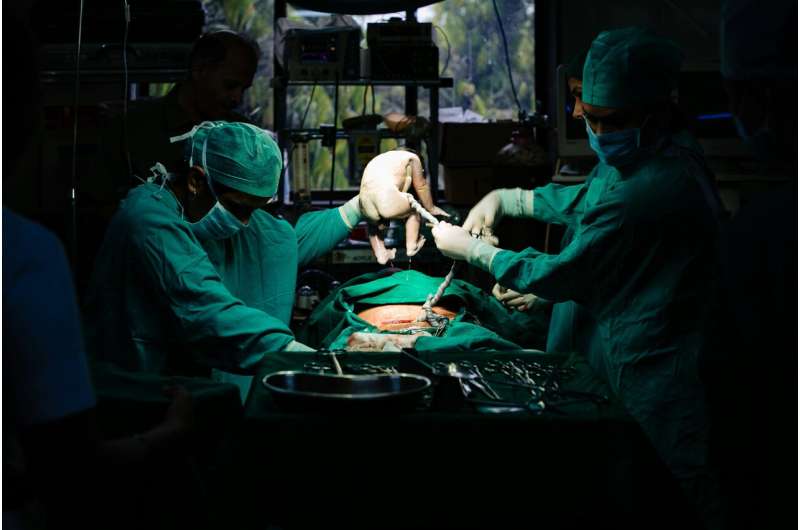This article has been reviewed according to Science X's editorial process and policies. Editors have highlighted the following attributes while ensuring the content's credibility:
fact-checked
peer-reviewed publication
trusted source
proofread
Umbilical cord milking does not appear to increase risk of neurodevelopmental delay in non-vigorous infants

A treatment to move blood from the umbilical cord into the body of newborns who are limp, pale and with minimal breathing, known as non-vigorous, does not appear to increase the risk of neurodevelopmental impairment, according to a new study. The findings are published in the journal JAMA Network Open.
The study included nearly 1,000 full-term and near-term infants. Researchers compared the treatment, known as umbilical cord milking, to early clamping and cutting of the cord—undertaken so resuscitation efforts can begin as soon as possible.
The researchers conducted the current study in response to concerns raised by an earlier study suggesting that umbilical cord milking could increase the risk for brain injury in extremely preterm infants. The current study results indicated that umbilical cord milking is unlikely to increase the risk of brain injury in term infants, providing evidence that umbilical cord milking is a safe alternative for moving blood into a term infant's body when there isn't time to wait for blood to enter from the cord naturally.
Non-vigorous infants are at risk for complications such as low oxygen levels in the brain, cerebral palsy and stroke. Standard practice for non-vigorous infants is to immediately clamp and cut the umbilical cord so that resuscitation can begin.
In contrast, for vigorous, full-term infants, the current recommendation is to delay clamping and cutting the umbilical cord for at least 30 to 60 seconds after birth. This allows blood from the cord to enter the newborn's circulation. Compared to infants undergoing immediate cord clamping, full-term infants undergoing delayed clamping have higher levels of hemoglobin (a protein indicating the presence of red blood cells) and iron.
For the current study, the investigators evaluated children from a previous study with screening tests for neurocognitive development before the children reached 2 years of age. For the cord milking in the previous study, attending providers milked 20 centimeters of cord for two seconds, then repeated this procedure three times.
Of the surviving infants in the current study, 964 were evaluated with a developmental screening tool used to identify potential delays in children's development, known as the Ages and Stages Questionnaire-3. The 502 children in the umbilical cord milking group had scores ranging from 225 to 280, similar to 469 children ranging from 230 to 280 in the early cord clamping group.
A total of 927 surviving children were evaluated with a screening tool used to assess risk for autism spectrum disorder (ASD) in toddlers, known as the Modified Checklist for Autism in Toddlers, Revised with Follow-Up. Proportions of children scoring with medium-to-high risk for ASD did not differ significantly for both groups: 45 of 486 in the umbilical cord milking group and 37 of 441 in the early cord clamping group.
The previous study had found that compared to non-vigorous infants who had early cord clamping and cutting, infants in the umbilical cord milking group were less likely to need heart and respiratory support, less likely to have a low level of oxygen and/or blood in the brain, and more likely to have higher levels of hemoglobin. A follow-up study found that compared to those with early cord clamping and cutting, non-vigorous infants who had cord milking had an increase in blood pumped from the heart and more blood flow to the lungs and brain.
The authors concluded that combined with the benefits seen in their previous studies, umbilical cord milking is a reasonable intervention that does not appear to increase the risk of neurodevelopmental delays in non-vigorous full-term and near-term infants.
The study was conducted by Anup Katheria, M.D., of the Sharp Mary Birch Hospital for Women and Newborns in San Diego, and colleagues at institutions in the United States, Canada and Poland.
More information: Anup C. Katheria et al, Two-Year Outcomes of Umbilical Cord Milking in Nonvigorous Infants, JAMA Network Open (2024). DOI: 10.1001/jamanetworkopen.2024.16870
















